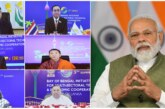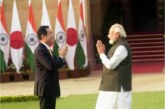By Madan Lal Sharma
 Approximately two-thirds of Myanmar’s population are ethnic Burmans and the remaining one-third comprises seven major indigenous ethnic minorities, also called ethnic ‘nationalities’ – Shan, Karen, Rakhine, Mon. Kachin, Chin, Kayah – and more than 100 other recognized ‘ethinicities’many of whom are linguistic or dialect groups. Generally the central and upper plains of Myanmar are predominantly populated by ethnic Burmans. The minority areas are around in country’s borders, in the steep, rugged highlands that ring the central valley.this rugged terrain has been the battleground for generations of attempted rebellions by minority group armed forces.
Approximately two-thirds of Myanmar’s population are ethnic Burmans and the remaining one-third comprises seven major indigenous ethnic minorities, also called ethnic ‘nationalities’ – Shan, Karen, Rakhine, Mon. Kachin, Chin, Kayah – and more than 100 other recognized ‘ethinicities’many of whom are linguistic or dialect groups. Generally the central and upper plains of Myanmar are predominantly populated by ethnic Burmans. The minority areas are around in country’s borders, in the steep, rugged highlands that ring the central valley.this rugged terrain has been the battleground for generations of attempted rebellions by minority group armed forces.
Never the less, ethnic Burman and Buddhist history, culture and language are unquestionably the predominant social influences on national life. This has not protected the Burman majority from political repression and human rights abuses. But there is little doubt that ethnic minority groups have generally been the worst victims for much of the past five decades.
Mutual distrust, power struggles and tension over the hoarding of resources, including gold, gems and timber, have characterized the long history between the rulers of Myanmar – primarily of Burman background – and the many other smaller ethnic groups that comprise this Southeast Asian nation. According to the last official census in 1983, the Burman accounted for 69 percent of the Myanmar’s total population of more than 50 million.
Each ethnic group regards the protection of their individual languages, customs, culture and natural resources important to their national identity. At the same time, the government has steadfastly believed that a “crisis of the minorities” – internal conflict among Myanmar’s sizable minority communities, which make up one-third of the population – could undermine the country’s stability.
Until the 2010 presidential election, the military government had shown few concrete signs of addressing ethnic grievances, resorting instead to brutal crackdowns, which earned international rebuke and sanctions from potential donors. IRIN offers a brief overview of the complex ethnic mix that Myanmar hopes to meld into a flourishing modern state.
Main Ethnic Groups
Karen, Kachin, Karenni, Chin, Mon, Rhakine, Shan, Wa and Rohingya are the main ethinc minorities of Myanmar. Proportion of population and location of these ethnic groups is shown in the following table:
| Ethnic group | Proportion of population | Location |
| Karen | 7 percent | Karen State in eastern Myanmar bordering Thailand |
| Kachin | 1.5 percent | Kachin State in the north, bordering China |
| Karenni | 0.75 percent | Karenni State, on the border with Thailand |
| Chin | 2.5 percent | Chin State in western Myanmar, bordering India |
| Mon | 2 percent | Mon State in southern Myanmar |
| Rhakine | 3.5 percent | Arakan State in western Myanmar |
| Shan | 9 percent | Shan State, bordering Thailand |
| Wa | 0 .16 percent | Wa Region, on the border with China |
| Rohingya | 0.15 percent | Northern townships of Rakhine State, bordering Bangladesh |
Most of these ethnic groups have their armed outfits as well. The Karen National Liberation Army (KNLA) took up arms in 1949, almost immediately after the British left Myanmar, making it one of the oldest rebel armies in the world. The KNLA is the military wing of the Karen National Union (KNU). In 1961, after a coup led by General Ne Win (1958-1988), Kachin rebels formed the Kachin Independence Army (KIA), the military wing of the Kachin Independence Organisation (KIO).
The Karenni Army (KA) was created after the Burmese government incorporated Karenni State into the Union of Burma in 1951. Karenni leaders argued they had not agreed to incorporation. The KA is the military wing for the Karenni National Progressive Party (KNPP). The Chin National Front (CNF) was founded in March 1988 as a coalition of several Chin opposition groups to push for greater autonomy. The New State Mon Party (NSMP) established an armed wing that has fought the government since 1949, when military forces entered Mon territory.
The Arakan Liberation Army (ALA) was first set up with the help of the KNU in the 1950s but it became defunct after most of its leaders were arrested. In the 1970s it reassembled, but is still one of the smallest ethnic armies. The Shan State Army (SSA) was formed in 1964 as Burmese military began to move into Shan State. The SSA later split into two factions, creating the Shan State Army-North, which signed a ceasefire with the government in 1964, and the Shan State Army-South, which continued to fight the state until an initial ceasefire in December 2011. The United Wa State Army (USWA), created after the fall of the Community Party Burma in 1989, is one of the country’s most powerful ethnic armies and receives military resources, infrastructure and support from neighbouring China.
Besides, there are various splinter groups. As various leaders have left major armies and created new militias, some have signed ceasefires with the Myanmar government and enjoyed freedom to trade with neighbouring countries, including the Karen (Democratic Buddhist Army, Karen Peace Council Kokang, Myanmar National Democracy Alliance Army) and Kachin (New Democratic Army and Kachin Defence Army).
Before British forces pulled out in 1947, they attempted to unite Myanmar’s various “nations”. With British officers as witnesses, many ethnic groups signed the Panglong Agreement, intended to be binding on the post-colonial administration, which would guarantee ethnic rights and self-determination, and the inclusion of minorities in the democratic process.
Aung San, a leader of the Burman ethnic group, who had led the country to independence (and was the father of current opposition leader Aung San Suu Kyi), and leaders of the Shan, Kachin and Chin negotiated the agreement. However, Aung San was assassinated soon after and the Burmese military began its slow advance into the ethnic states to rule by force.
Many ethnic groups took up arms to protect their states from Burman rule, demanding autonomy, ethnic rights and an inclusive democracy. Their demands have remained unchanged. In a recent interview with the media, Lama Gum Hpan, a KIO “Central Committee” member, said: “The Kachin fighters have always stood by the Panglong Agreement.To this day we wish for the Burmese government to honour the agreements made in 1947.” In the run-up to the 2010 elections of the nominally civilian government in power, a proposal for a border guard force was drafted, which aimed to include ethnic groups in the state army – and called for their disarmament. Nearly all the ethnic armies refused and several ceasefires faltered. Myanmar’s dissident media have compiled a list of ceasefires dating back more than two decades between the government and major rebel groups as well as splinter movements.
Recent peace deals – still in their early stages – have been inked: the Shan State Army-South (SSA-S) signed in December 2011, the Karen National Liberation Army (KNLA) and New Mon State Party (NMSP) in February 2012. This has not stopped clashes. The Myanmar government has blamed persisting army incursions on communication problems between the seat of government in Nay Pyi Daw and frontline troops at least 500km away. The central government ordered its troops to halt fighting on 12 December 2011 but a number are still firing.
Despite faltering peace on the frontlines, rebel leaders from the Myanmar’s ethnic armies have noted change in the government’s willingness to engage. In a recent speech to parliament reported in local media, Myanmar President Thein Sein said long-time enemies have the same goal: “The expectation of ethnic groups is to get equal rights for all. Equal standards are also the wish of our government.” Discussing the ongoing conflict with the Kachin, Thein Sein said: “Fighting will not stop by pointing the finger of blame at each other. Ceasefires are first needed on both sides for political dialogue. We all have to work so our ethnic youths who held guns stand tall holding laptops.” Analysts note most ceasefires are in nascent stages and have a long way to go, but if the government can control its military, a thus-far elusive peace with ethnic rebels is within reach.
 According to the Thailand Burma Border Consortium (TBBC), due to conflict more than 400,000 people are believed to be living in internal displacement in the southeast, while some 150,000 refugees, asylum seekers and others fleeing violence in Myanmar are in camps in Thailand. If the ceasefires hold, many may return to Myanmar, Sally Thompson, the TBBC’s executive director, said. “If the current momentum of political reforms continues, then it is unlikely that the camps will still be open in five years.”
According to the Thailand Burma Border Consortium (TBBC), due to conflict more than 400,000 people are believed to be living in internal displacement in the southeast, while some 150,000 refugees, asylum seekers and others fleeing violence in Myanmar are in camps in Thailand. If the ceasefires hold, many may return to Myanmar, Sally Thompson, the TBBC’s executive director, said. “If the current momentum of political reforms continues, then it is unlikely that the camps will still be open in five years.”
According to media reports, many refugees across nine camps along the 1800km-long border Thai-Burmese border feel that it is still too early to tell if recent respites in the conflict will last long enough for them to return home. Saw Plu, a Karen elder, said he believed the Myanmar government was “playing a trick”, and fighting will inevitably erupt again. Yet despite their concerns, the vast majority of refugees voiced their desire to go home and is waiting for signs of a “genuine” peace.
Ethnic minority groups in Myanmar are calling on the international community to set stronger benchmarks or steps in the incremental removal of international sanctions, following announcement by the European Union (EU) in the last week of April this year, to suspend sanctions for a year, retaining only the embargo on arms sales. Zipporah Sein, general secretary of the Karen National Union, told the media on 27 April this year: “Now more than ever, it’s important that our voice is heard. If sanctions are to be lifted, it’s important that specific benchmarks be put in place.” Many argue there can be no real progress towards democracy until the country formerly known as Burma makes peace with all its ethnic groups.
Viewed as key to the development of Myanmar, the suspension of EU sanctions announced on 23 April is seen as another major endorsement of Myanmar President U Thein Sein’s recent political reforms, which include the release of hundreds of political prisoners, new laws allowing labour unions and strikes, a gradual easing of media restrictions, and ceasefire agreements with various ethnic rebel groups. Now, a shift in government discourse and a recent string of cautious ceasefires have prompted people to wonder whether peace will last this time and what it will bring to participants in the longstanding civil conflicts, how it will affect the regional refugee crisis, and what it will mean for the recent relaxation of restrictions and a more open Myanmar.




